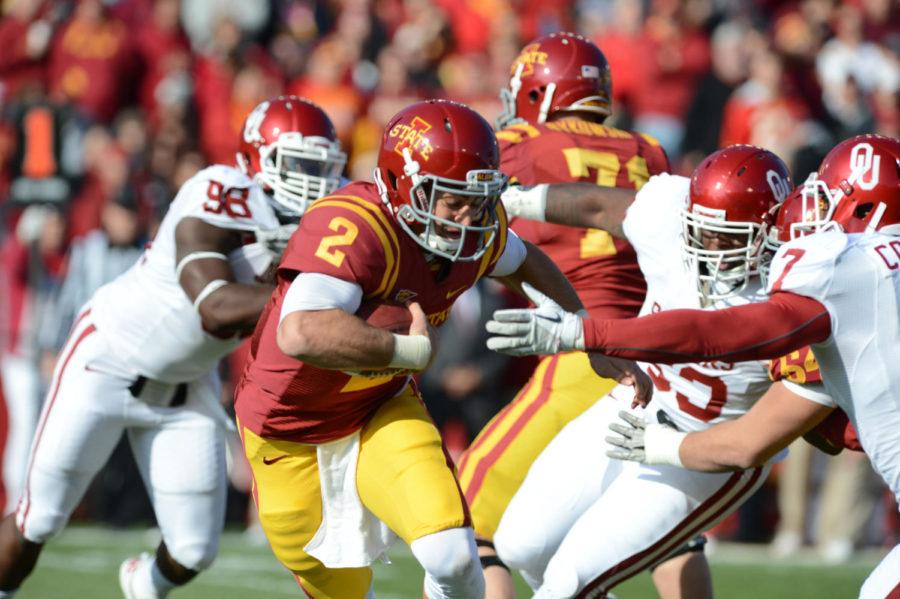Total yardage lacking, running game improving for ISU football
Quarterback Steele Jantz runs the ball against Oklahoma on Nov.3, 2012, at Jack Trice Stadium. Jantz gained 44 yards in the 35-20 loss to Oklahoma.
November 5, 2012
Paul Rhoads said he is not concerned as much about total yardage as he is with scoring.
But the fourth-year ISU football coach’s team is 1-4 when it has been out-gained by opposing offenses, a stat that has seen gaps of at least 105 yards in those five games and an average of 206.2 yards per game.
“You keep on trying to figure out ways to gain yards,” Rhoads said at his weekly news conference Monday. “Whether you’re throwing or catching passes or figuring out a way to run the football.”
Even though points are more important to Rhoads than total yardage — as was the case with Iowa State’s 14-point win Oct. 6 at TCU — the Cyclones (5-4, 2-4 Big 12) have lost by an average of 13.5 points per game in their four losses, all of which they failed to out-gain their opponents in total offense.
But Saturday’s loss to Oklahoma showed signs of improvement for the ISU offense. Chief among them was the offense’s 60 of its 99 rushing yards off six carries coming in the third quarter and more than half of its passing yards coming in the fourth quarter before a late interception from Steele Jantz sealed the game.
“We’re getting better every week,” said running back Jeff Woody. “Those narrow misses that we had as far as playwise — where a ball will be short or a ball will be long or we’d drop a pass or something like that — those misses are getting smaller and fewer and far between.”
Play-calling has not been a topic of unrest on the team, as Rhoads reiterated his trust in Jantz’s ability to make something out of nothing when a play doesn’t develop the way it should.
Jantz had a team-high 11 carries on Saturday, scrambling for two first downs in the process. Jantz’s total number of carries, however, equaled the combined number of carries by running backs Shontrelle Johnson and James White.
“When you run zone read, if they’re taking away the running back run option, it’s his job to pull it and run,” said center Tom Farniok. “Some days, he’ll run the ball 20 times if they just are solely taking away the running back, sometimes he might not run at all if they’re focused on stopping him from running it.”
Johnson and White rushed for a combined 55 yards. White averaged 6.8 yards per carry and Johnson also recorded his first rushing touchdown since the team’s season-opening win against Tulsa.
“We found some space that we haven’t found against other people and against a team that defends the run very well and is committed to stopping the run,” Rhoads said. “I thought the offensive staff did a nice job of finding those plays.”
However, the offense was forced to pass twice as much in its 64 plays run Saturday. Farniok said this has only added frustration to a unit that has been on the verge of finding success on the ground.
Of the positives that emerged from the running game on Saturday, Rhoads said two had stuck out in his mind — his backs were operating in space and were making defenders miss tackles.
The employment of receiver Jarvis West has also helped mend the woes of the ISU running attack.
West, a 5-foot-7, 170-pound redshirt sophomore, recorded his first rushing touchdown in five attempts on reverse runs Saturday — a 19-yard scamper that pulled Iowa State to within eight in the third quarter.
“We called it, and I got on the edge and just went through everything they tell us to do on a special play, and I got in the end zone,” West said. “I just saw the dude coming from the side of me, so I just figured I had three, four yards to go, so I might just find my way into the end zone.”







